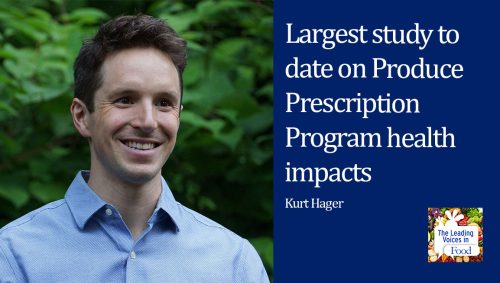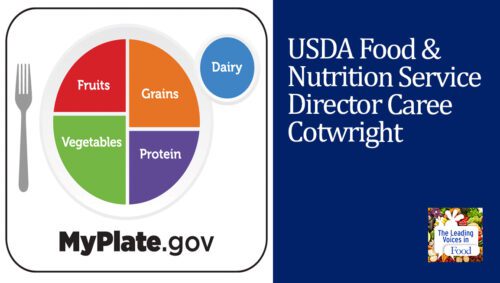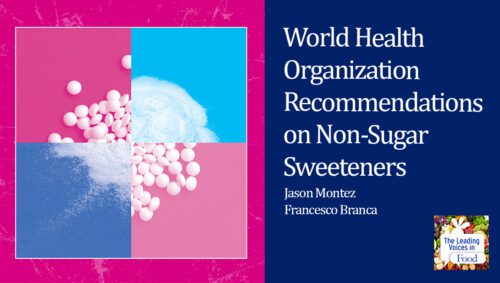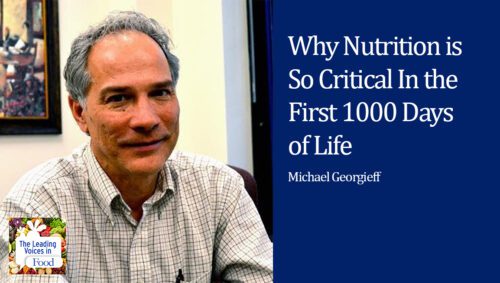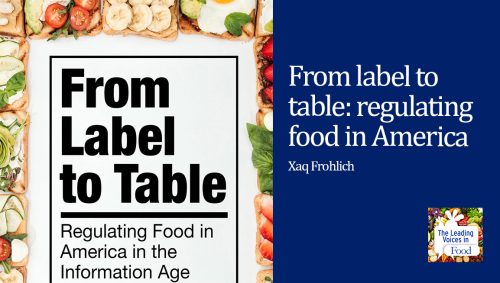E110: Policy and Medical Practice Need to Better Support Breastfeeding
Breastfeeding is front and center in discussions of maternal and child health. But optimizing breastfeeding practices is anything but simple. There’s no person better suited to discuss the challenges and opportunities in this area than our guest, Dr. Rafael Perez-Escamilla. Perez-Escamilla is director of the Office of Public Health Practice, and professor of epidemiology and public health at the Yale University School of Public Health.
Subscribe: Apple Podcasts | TuneIN | Google Podcasts | SoundCloud | PocketCasts | Radio Public
Tags: Child Development & Nutrition | Childhood Obesity | Children Food Preferences | Diet & Nutrition | Food Policy | Social Safety Net & Food |

Rafael Pérez-Escamilla, Ph.D., is Professor of Public Health, Director of the Office of Public Health Practice, and Director of the Global Health Concentration at the Yale School of Public Health. He is the PI of the Yale-Griffin CDC Prevention Research Center (PRC). His global public health nutrition and food security research program has contributed to improvements in breastfeeding and other maternal, infant and young child nutrition outcomes, iron deficiency anemia among infants, household food security, and early child development. His health disparities research involves assessing the impact of community health workers at improving behavioral and metabolic outcomes in vulnerable communities.
Interview Summary
To launch our discussion, I’d like to ask how important is breastfeeding to the wellbeing of the child, to the mother, and to the public health overall?
Yes indeed, breastfeeding is incredibly important not only to the health of the child and the mother, but of course the wellbeing of their families’ development of the countries in which they live, and also for the health of our planet. We know that with regards to children, for example, breastfeeding protects against the risk of diarrhea, of respiratory infections, of ear infections, and also it protects against the risk of the development of obesity and leukemia. And at the end of the day breastfeeding makes humans more intelligent because it improves their cognitive development.
When we talk about breastfeeding we also have to take into account that for the mothers it offers major health benefits as well. It reduces the risk of breast, ovarian, and endometrial cancer, as well as the risk of maternal hypertension, stroke, and Type 2 diabetes. So it is not surprising then that for the countries as a whole, breastfeeding not only leads to improve human development but at the end of the day this translates into improved family productivity, and improved national development.
“The Lancet” breastfeeding series estimated that the world loses over one billion dollars per day as a result of lack of investments for breastfeeding protection and support. And last but not least, when we think about the planet, breastfeeding improves environmental sustainability because we know that for example, it takes 4,000 liters of water to produce one kilogram of powdered infant formula. The production of infant formula leaves a major carbon footprint as a result of the fossil fuels that are needed to produce, transport, and also store the infant formula products. And there are hundreds and hundreds of thousands of waste accumulating every year with regards to the disposal of plastics that come from the bottles, the metal waste that comes from the containers that have the formula. And at the end of the day, also we know that dairy cows are major producers of methane or greenhouse emissions. So no matter how you cut it, no matter how you look at it, breastfeeding offers immense benefits from the child, all the way to the health of the planet.
What an impressive picture you’ve painted, and you have to wonder then why there’s not an all-out pursuit everywhere in the world to maximize breastfeeding rates. We’ll come back to that in a minute. But first let me ask how do rates and duration of breastfeeding vary around the world?
Yes, that is a great question because there is an enormous amount of variability globally. So when we look at the most recent data from UNICEF, we know that with regards to the recommendation to exclusively breastfeed for the first six months of life, that prevalence or the percentage of infants actually being exclusively breastfed ranges from 0.1% in Chad, in Sub-Saharan Africa, all the way to 88.4% in Colombia. And by the way, the U.S., the prevalence of exclusive breastfeeding among children under six months of age is 25% to put these numbers in perspective. When we look at any breastfeeding, we know that there is also a very, very wide range. So when we look at the percent of babies that receive any breastfeeding up to one year of age, this ranges from 20% in Belarus, to almost 100% in Nepal, Senegal, and Malawi. And to put this in perspective, the prevalence of any breastfeeding at 12 months in the U.S. is around 36%.
Those numbers are stunning, aren’t they, in how much variability there is? What are some of the factors that contribute to that variability?
First of all, we have to acknowledge the fact that many women globally are now employed either in the formal or the informal economy. And what this means is that if we don’t have strong maternity benefits, and maternity leave legislation, and I’m talking about paid maternity leave, then it is becoming very challenging for women to be able to breastfeed their babies for as long as they want to do and for as long as it is recommended by the health organizations such as the World Health Organization, UNICEF, and the American Academy of Pediatrics.
We also have a major issue with regards to unethical marketing practices by infant feeding companies. So since the 1980s, the World Health Organization released a very comprehensive code to actually regulate the marketing of breast milk substitutes. And that code clearly forbids the direct marketing of infant formulas and follow on formulas. Those that are being marketed for children between one and three years of age. There are strong restrictions on the use of images or messages in infant formula containers suggesting equivalency with breast milk, as well as the sponsorship of breastfeeding conferences by infant formula companies. And of course the enormous problem of the creation of conflict of interest by sponsoring health professionals’ trips, meals, and registrations to meetings. Unfortunately, infant formula companies continue to violate the code and as a result especially lower income women and very heavily targeting low income countries where the growing market for infant formula sales is, are being very, very heavily exposed to marketing that should not be happening if countries were enforcing these code of conduct with regards to marketing practices.
A third factor that is very important here, Kelly, is the fact that Allied Health schools are not preparing well — the doctors, the nurses, the midwives — with regards to breastfeeding, and developing their abilities and their skill sets to help support women manage their lactation problems. So we also have the whole issue that we need to have a much competent workforce globally to be able to properly serve the breastfeeding support needs that women have no matter where they live.
Rafael, if we could go back to the issue that you raised about the behavior of the infant formula companies, the science would suggest that their products should not be encouraged. Then what’s the option? What can be done to help address this given that they continue their practices in the face of recommendations from places like the World Health Organization?
So two actions are very important to consider. First of all, the implementation, the adoption of the code is voluntary, and essentially relies on self-regulation by infant formula companies. And we have seen already two decades of experience that self-regulation just does not work. So it is very important that actually the governments take on this responsibility and develop the legal frameworks, and develop the infrastructure that is needed for enforcing the code. And it really needs to have attached to it strong penalties for companies that violate it. Right now, the penalties are just not severe enough to dissuade any company from actually violating the guidelines on this code.
In the U.S., we also have the additional problem that it is the only high income country that never agreed to signed the code. So the U.S. is a very difficult environment to try to enforce this code for that reason. So the other option, which is an approach that I have actually learned a lot from researchers like you, is how to better educate the public at large. So how can we really create the conditions for public itself to demand for these practices to stop? And we know that in the ‘70s and ‘80s there was a huge boycott, for example, against Nestle, of the infant formula companies, because of very, very unacceptable behavior regarding the marketing and sales of their infant formula products, especially in Sub-Saharan Africa. And that had an impact that actually brought the whole issue to the attention of the world, and actually really helped this company change a little bit the way they were conducting themselves with regards to marketing and sales of their products in Sub-Saharan Africa.
And I would like to add that I would really love for all the schools of medicine, and nursing, and midwifery, and so on to actually include courses or a curriculum on what conflict of interest means. Because I think for young health professionals who have a debt, or are not making enough money from their practice it is very tempting to agree to accept gifts, trips, and so on from companies, but they really need to understand that it is a huge conflict of interest with enormous implications for the health of the children and families in their countries
Can you explain the concept of baby-friendly hospitals?
So the Baby-friendly Hospital Initiative was launched in 1991 by the World Health Organization and UNICEF based on 10 steps that help improve the ability of women to successfully breastfeed their babies before, during, and after the birth of that baby. So these steps range from having a written policy that the maternity facility is totally in support of protecting, promoting, and supporting breastfeeding to another step related to the fact that all the personnel that has contact with women and families that have newborns, and in fact even women who are pregnant, should be well-trained on how to support their breastfeeding decisions.
And the steps also include physical, structural issues because the babies and the mothers need to be together throughout the hospital. Stay in what we call rooming-in, skin-to-skin contact needs to start immediately after birth so that the babies start breastfeeding within one hour after birth. And then the whole issue of not only telling moms breast is best, but actually helping them latch their babies the first time they offer the breasts, and offering them very good advice on, for example, if they’re planning to go back to work how are they going to express milk, the breast pump, to be able to continue implementing their choice, their decision to breastfeeding. And very importantly, at the end of the day, now the Baby-friendly Hospital Initiative calls for only advocating for infant formula when it’s absolutely medical indicated, if the mother is choosing to breastfeed her baby. No free gifts from infant formula companies, no marketing from infant formula companies in the maternity ward. And very importantly that support and the counseling needs to start prenatally, and also postnatally the mothers need to know where they can find breastfeeding management support in the communities or in their neighborhoods once they go back to them after their hospital discharge.
I have been researching this initiative for 30 years, and there is conclusive evidence that it is very efficacious maternity wards that faithfully implement the 10 steps end up having much, much better breastfeeding outcomes in the short, medium, and long-term. And we also know from studies in the U.S. conducted by the CDC that the higher the number of steps that get implemented, the higher the success with breastfeeding outcomes. So the Baby-friendly Hospital Initiative, the guidelines have just been revised by the World Health Organization to understand why coverage has not been as high as it was originally intended. So we’re now entering a new phase of what I would call implementation science research in the area of the baby friendly hospital initiative, to actually help each country tailor that initiative to the needs of their context, their economic situation, their maternity leave situation, without losing the essence of what the 10 steps are all about.
In the United States as an example, do you have a general sense of the percentage of hospitals that are baby-friendly hospitals? And is that number growing?
The good news is that the numbers are growing. And in fact currently about one third of U.S. babies are being born in baby-friendly hospitals. Not too long ago it was about 5%. There is still a long way to go, there is a lot of room for improvement. At the end of the day, the needle is moving in the right direction. So in spite of everything, more and more women are choosing to initiate breastfeeding in the U.S., and more and more hospitals are choosing to become baby-friendly, which is indeed great news.
That’s very exciting. So in addition to the advance in baby-friendly hospitals, what do you think are some of the other exciting things that are going on around the world?
So I think we have totally entered now, as I said, the implementation science arena. And my research team is very engaged, developing tools for policymakers to actually understand how best to assess the enabling environment for breastfeeding in their countries, so that they can actually come up with smarter policies that can help scale up more rapidly, and more cost-effectively their breastfeeding programs. And our approach is not only generating a number or a score, but actually have the countries run a whole policy development process based on a participatory multi-sectorial approach so that at the end of the day the understanding of the enabling environments help make recommendations that can be implemented in the short term, such as extensions of maternity leave, improving coverage of the Baby-friendly Hospital Initiative, improving the pre-service training of healthcare professionals.
We have tested this policy toolbox, it’s called the Becoming Breastfeeding Friendly initiative in eight countries. And we have actually demonstrated how feasible it is, how helpful it is for policy makers, and that at the end of the day all the governments that have agreed to be a part of it have followed through with some policy development commitments. The key message here is that we understand a lot about lactation physiology, how milk gets produced. We understand a lot how to solve common breastfeeding difficulties, such as sore nipples, breast engorgement, mastitis, and so on. And we also understand pretty well now, thanks to the work we have done here at Yale University, which are the key elements that national breastfeeding programs need to have in place to make it work on a large scale, and in a cost effective manner. So here we have a treasure trove of knowledge, and it is really time to translate all this knowledge into practice globally, for the benefit of humankind.




